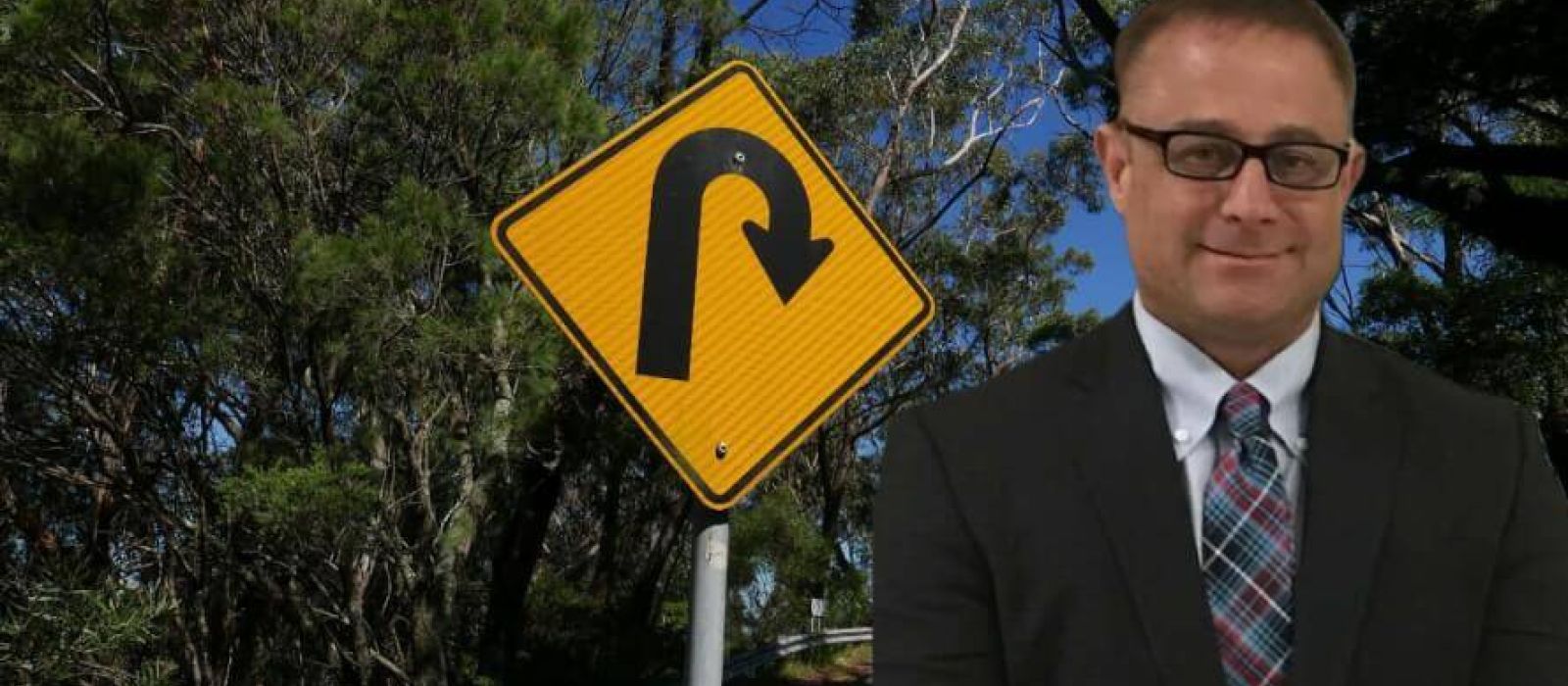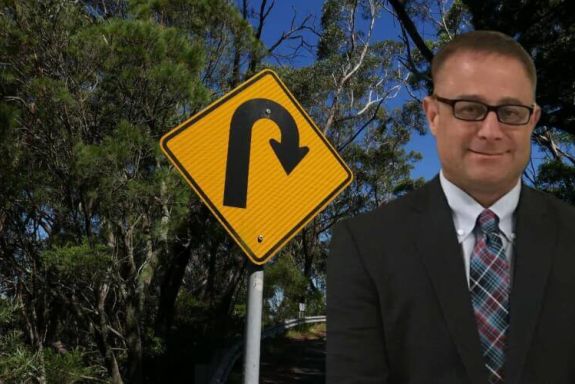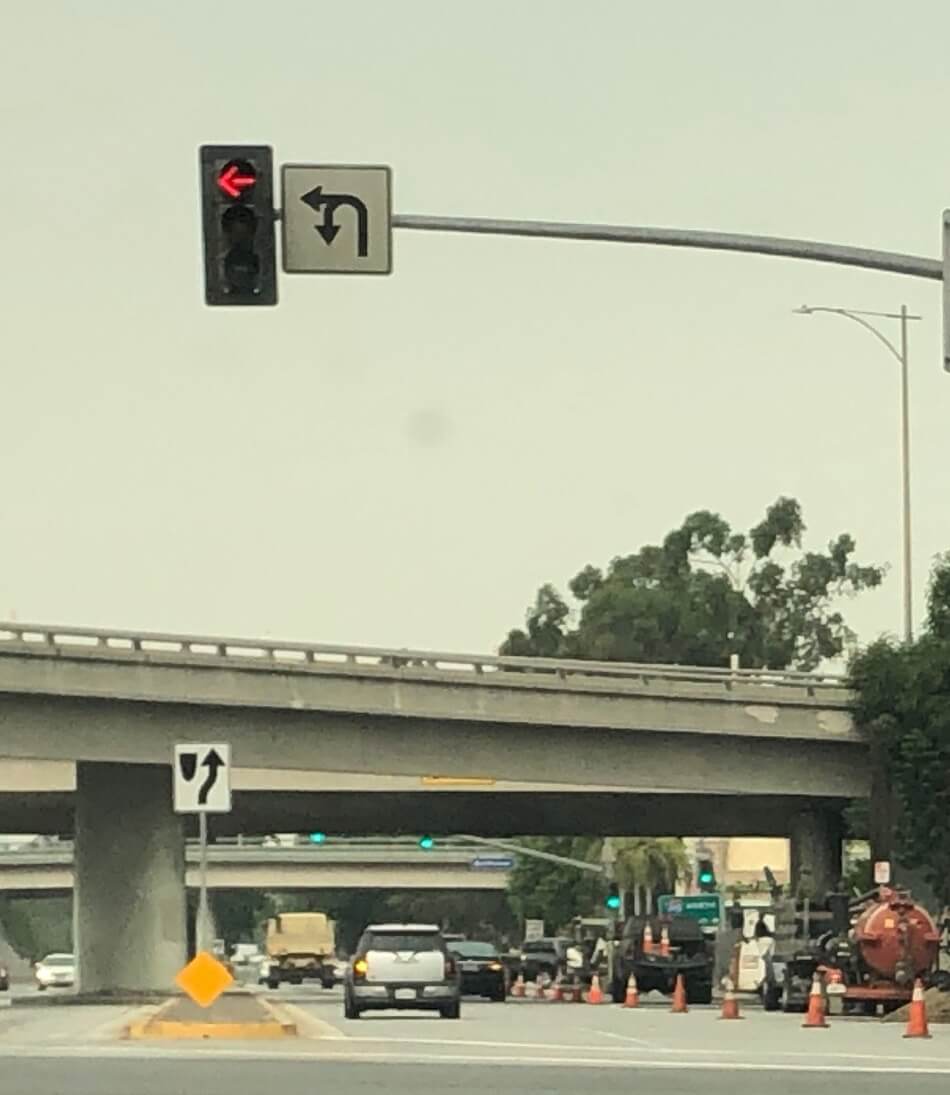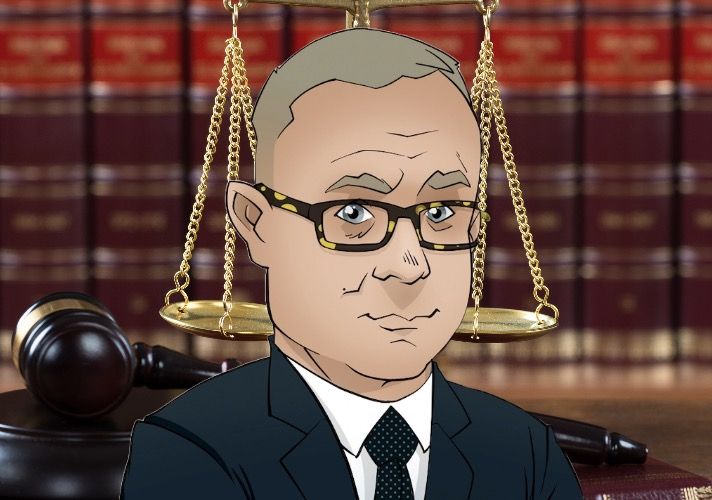If we don’t win, you don’t pay.
NO WIN – NO FEE

ON CALL 24/7

U.S. Marine

Injury Lawyer Explains The Legal Ramifications And Effects Of U-Turns In Negligence Claims
No two car accidents are the same. Our Los Angeles personal injury attorneys team has seen many causes of accidents and their effects on our decades of experience in the legal field. And even the best lawyers in one area of law are not the best lawyers if they don’t know what is covered below. In any event, one of the most common causes of California motor vehicle accidents is using a U-Turn to turn around.
Furthermore, what is incredibly difficult is that illegal turns cause many of these U-Turn accidents. Such illegal turns make it much more likely for a collision and even death. Still worse, the defendant will almost always deny liability, forcing you, the plaintiff, to hire an aggressive lawyer you can trust, such as Ehline Law’s staff.
- First of all, what is a “U-Turn?”
A U-Turn is defined as:
“noun 1. the turning around of a vehicle in a course that resembles a U-shape that is meant to face the vehicle into the opposite direction of traffic: “that car made an illegal U-turn and was broadsided by an approaching vehicle at high speed.” Synonyms include “one-eighty,” “about-turn,” about-face,” informal: “U-ey,” “flip-a-bitch.” (See Ehline Legal Dictionary).
It also means that the action that many drivers don’t think twice about may cause a life-changing incident. Because of the frequency of such turns, this makes the odds of a U-Turn accident more likely. And since many of these U-Turns happen at intersections, you may have one vehicle traveling at high speed approaching the turning vehicle as it slows to make its loop around.
Sudden Turns Can Mean Sudden Death?
But it may be too late for the oncoming vehicle because the driver or navigator and even specialized accident avoidance systems may only see the other car suddenly turn in front of them immediately before T-boning (aka broadside) or sideswiping by the scofflaw driver. So by then, it’s far too late to avoid a loud, nauseating impact accompanied by the sounds of breaking glass and clunking, twisting, and banging metal.
And as noted above, this type of collision makes severe injury or even death more likely. For example, even if a motorist, pedestrian, or motorcycle rider survives the initial crash, you have to worry about other vehicles entering an intersection or crash zone. The cars causing a secondary crash often run over the victims or cause a pile-up at the intersecting points.
And this remains particularly true in heavy rains and foggy conditions. Furthermore, this means that piecing together the accident’s cause is often more difficult due to the debris field, tire skid marks, and several parties involved.
Congratulations – We Are Top Lawyers Near You Specializing In U-Turn Collision Accidents!
Ehline Law specializes in U-Turn accidents in part because of our experience. We have seen these types of accidents many times before and studied their causes and their effects. Furthermore, our team also operates on a clear understanding of CA state highway law and many case studies of similar U-Turn accidents. Below we discuss some of California U-Turn accidents’ legal concerns and effects.
Michael Ehline is second to none when it comes to handling car accidents in Southern California. In particular, Ehline and his team are specialized in U-Turns and related accidents. This often is a crucial difference for our clients after an accident. The legal team learned many of these lessons both in the courtroom and through numerous experiences. Besides, Ehline Law specializes in these cases due to our decades in the legal field.
Our lead attorney, Michael Ehline, included the skills that many attorneys learn at law school. But for him, there is so much more. Before going to law school, Ehline read the law under a judge to take the bar exam. This gave him a particular understanding of the practical side of the law and the courts. This also gave him insight into how our clients see the process unfolding before them.
And as a disabled former Marine, Ehline pledged to do everything he could to aid our clients in their time of need. Ask our former clients, and this made a critical difference. We fought and won for hundreds of clients over the years– winning millions for them. Our team stops at nothing when our clients need help. And we treat them like family rather than just a case file.
It’s for these reasons and more that Ehline Law compiled our fantastic record of victories– and why we want to use it to help you. For more info, contact us at the number below or at losangeles@ehlinelaw.com. Feel free to fill out our contact form here. We are here for a free, no-pressure consultation to discuss your legal options 24 / 7.
Understanding Legal vs. Illegal U-Turns
To better understand such a U-Turn effect, we must better understand how the law itself regards these turns. In most states, U-Turns are legal when safe on most parts of the road.
Some intersections even include unique lights allowing for U-Turns right then and there. Furthermore, we can review the difference between legal and illegal U-Turns straight from the CA state DMV.
For Example, A Review Of Legal v. Illegal U-Turns
California maintains multiple statutes, codes, and ordinances designed to clarify when U-turns are allowed and proscribed. California’s laws deal with a wide array of U-turn-making at controlled intersections.
Moreover, they cover turning your car around while driving in residential locales and districts. And for those of you too daft to get it, there are even laws about illegally turning around on public freeways and highways.
Yes, that’s right, just like rioters shouldn’t block the roads, drivers should not make U-Turns on Freeways! Did you know there are even laws dealing with illegal U-Turns dealing with parking lots and fire station driveways?
As noted above, legal U-Turns are a way of turning your vehicle around in the street to go back the way you came. Below, our illegal U-Turn accident lawyers will cover a few tips when making turnarounds on the highway.
- How Do I Make A Legal U-Turn?
To make a legal U-turn, signal and use the far left or center left-turn lanes when safe and not otherwise illegal.
Below is a synopsis of when a U-Turn is legal, and further down, we will cover the relevant Vehicle Code sections in more detail.
You may make a legal U-turn:
- Across a double yellow line when it is safe and legal.
- In a residential district:
- If no vehicles are approaching you within 200 feet.
- Whenever a traffic sign, light, or traffic signal light protects you from approaching vehicles.
- At an intersection on a green traffic signal light or green arrow, unless a “No U-turn” sign is posted.
- On a divided highway, only if an opening is provided in the center divider.
When Is A U-Turn Illegal Under California Law?
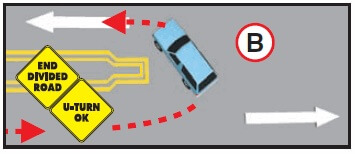
But alas, certain things are considered dangerous to drivers; those hard and fast rules are outlined in the California Vehicle Code.
Below we will explore the relevant prohibited U-turns and discuss them in more detail from an injury attorney’s perspective.
Are “U” Turns Legal At Intersections Controlled By Traffic Signals?
Again, common sense prevails here, but with a few hard, fast exceptions. So yes, it is legal as a general rule. Let’s see what the Vehicle Code says.
According to California Vehicle Code Section 22100.5:
“No driver shall make a U-turn at an intersection controlled by official traffic signals except as provided in Section 21451, and then only from the far lefthand lane that is lawfully available to traffic moving in the direction of travel from which the turn is commenced. No driver shall make a U-turn at an intersection controlled by official traffic control devices except from the far lefthand lane that is lawfully available to traffic moving in the direction of travel from which the turn is commenced.” (Source).
As noted above, Section 22100.5 provides that vehicle operators are authorized to make U-turns when approaching an intersection on a green light.
But this only remains lawful if no traffic sign or signal explicitly prohibits U-turns at that intersection or light. But don’t forget that U-turns are “illegal” in certain parts of commercial or “business” zones. (whatever that is). And we will cover that further down the page.
Moreover, drivers approaching intersections upon a green light can’t just assume it’s safe to make their turnabout. No, they are still expected to yield to all oncoming traffic and traffic in any oncoming or side lane, maintaining their right of way.
Moreover, drivers must yield to people on foot, such as a mother and child in an adjacent crosswalk or “presumed” crosswalk.
- The Companion Code to the above California Vehicle Code Section 21451 states:
(a) A driver facing a circular green signal shall proceed straight through or turn right or left or make a U-turn unless a sign prohibits a U-turn. Any driver, including one turning, shall yield the right-of-way to other traffic and to pedestrians lawfully within the intersection or an adjacent crosswalk.
(b) A driver facing a green arrow signal, shown alone or in combination with another indication, shall enter the intersection only to make the movement indicated by that green arrow or any other movement that is permitted by other indications shown at the same time. A driver facing a left green arrow may also make a U-turn unless prohibited by a sign. A driver shall yield the right-of-way to other traffic and to pedestrians lawfully within the intersection or an adjacent crosswalk.
(c) A pedestrian facing a circular green signal, unless prohibited by sign or otherwise directed by a pedestrian control signal as provided in Section 21456, may proceed across the roadway within any marked or unmarked crosswalk, but shall yield the right-of-way to vehicles lawfully within the intersection at the time that signal is first shown. (d) A pedestrian facing a green arrow turn signal, unless otherwise directed by a pedestrian control signal as provided in Section 21456, shall not enter the roadway.” (Source).
As noted above, you can’t just turn around unless it’s safe, and so long as there is no signage saying you can’t. Also, the Code admits there are also “unmarked” crosswalks, which the uneducated person may assume is a places where pedestrians are “jaywalking.”
And don’t forget that even if you have a confusing left green arrow, it may still be prohibited based on some other exclusionary rule like a detour sign, road construction, or even a time of day issue proscribing a U-turn. (Ex: “No U-Turns from 6:00 am to 10:00 am.”)
RECAP: California vehicle drivers in California are permitted to make U-turns at intersections with traffic control devices unless a sign prohibits such action under California Vehicle Code Section 21451. That code specifies that drivers are allowed to make U-turns when approaching an intersection with a green light unless signs prohibit U-turns.
But even if it is legal, drivers must yield right of way to all oncoming traffic. And motorists wishing to turn around in such a fashion must yield to pedestrians occupying adjacent crosswalks. (But again, the turn must be safe – Ex: You can’t run over a “jaywalker” and get away with it.)
Are U-Turns Legal in “Business Districts?”
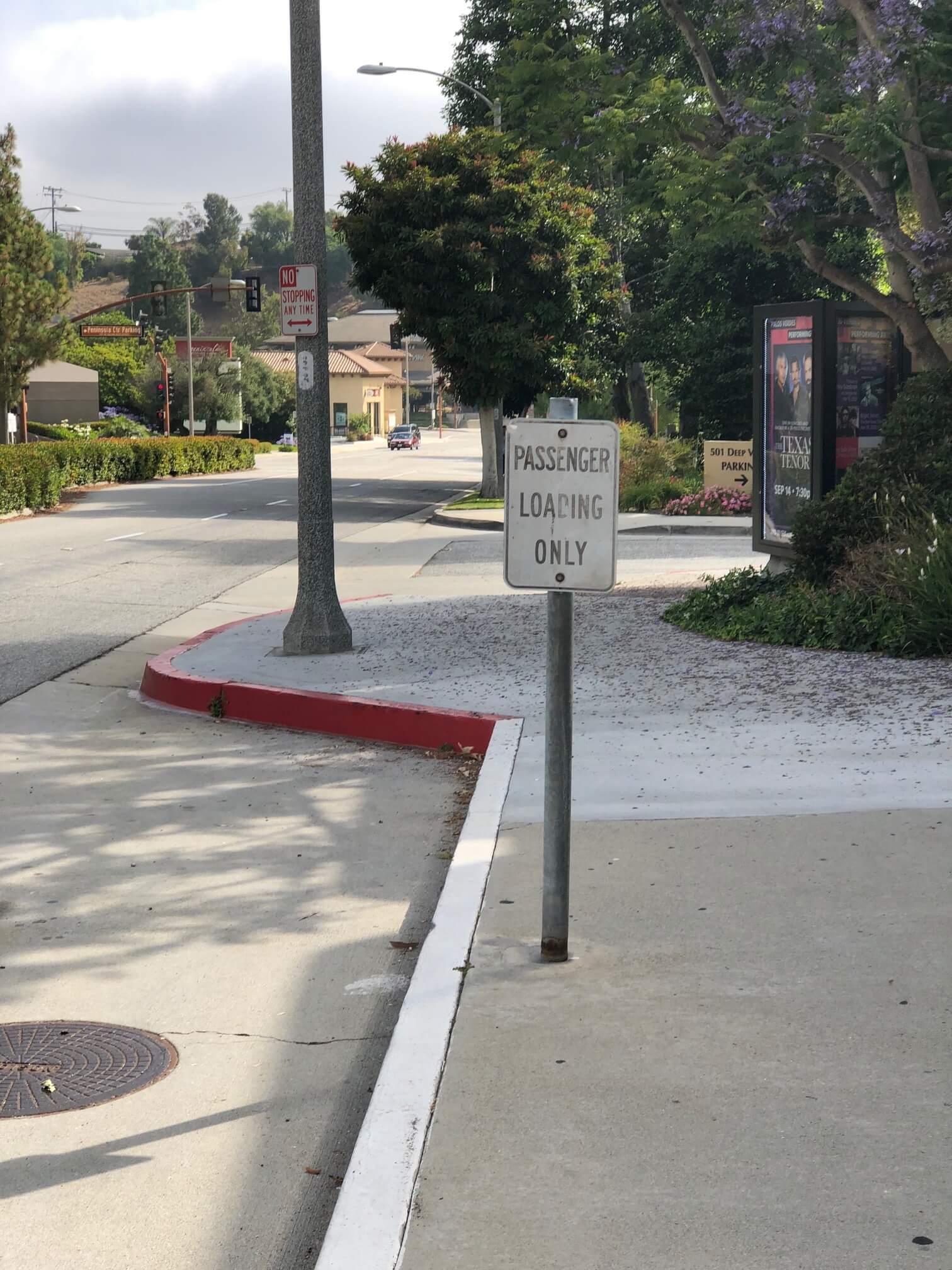
Moreover, pedestrians are present in more massive amounts in many of these commercial zones. Think about it. They are using Del Amo Mall in Torrance as an example. You will have kids walking across Hawthorne Boulevard from 24 Hour Fitness or another establishment to get to Lucile’s BBQ or EMC to grab lunch, for example.
Now throw in all the UPS, FedEx, and USPS delivery vehicles. Then consider the big rigs dropping off goods or packing up all the closed-down businesses bankrupted by the government shutdowns due to COVID-19. Imagine all these commercial vehicles zipping in and out of the mall’s loading dock areas and pedestrian and vehicle traffic headed to and from the parking structure.
You can see why the DMV has rules to make U-Turns illegal and for slower speeds in these areas now, right? So here, the idea is public safety. So let’s look at the actual Vehicle Section dealing with U-turns in business zones below, so we don’t get in trouble.
- So, in addition to reduced speeds in commercial and business areas, “Turning and Stopping and Turning Signals” are discussed under California Vehicle Code Section 22102, which states:
“No person in a business district shall make a U-turn, except at an intersection, or on a divided highway where an opening has been provided in accordance with Section 21651. This turning movement shall be made as close as practicable to the extreme left-hand edge of the lanes moving in the driver’s direction of travel immediately prior to the initiation of the turning movement, when more than one lane in the direction of travel is present.” [Emphasis] (Source, California Legislative Information).
In other words, look at California Vehicle Code Section 21651 if you are not sure whether the turn is legal. Here, you cannot make a U-Turn in a business district unless under a specific fashion because you can only turn around at an intersection or on a divided highway following Section 21651 below.
- California Vehicle Code Section 21651 states:
“Driving on Right Side – [21650 – 21664] (Article 1 enacted by Stats. 1959, Ch. 3.) 21651. (a) Whenever a highway has been divided into two or more roadways by means of intermittent barriers or by means of a dividing section of not less than two feet in width, either unpaved or delineated by curbs, double-parallel lines, or other markings on the roadway, it is unlawful to do either of the following:
(1) To drive any vehicle over, upon, or across the dividing section.
(2) To make any left, semicircular, or U-turn with the vehicle on the divided highway, except through an opening in the barrier designated and intended by public authorities for the use of vehicles or through a plainly marked opening in the dividing section.
(b) It is unlawful to drive any vehicle upon a highway, except to the right of an intermittent barrier or a dividing section which separates two or more opposing lanes of traffic. Except as otherwise provided in subdivision (c), a violation of this subdivision is a misdemeanor.
(c) Any willful violation of subdivision (b) which results in injury to, or death of, a person shall be punished by imprisonment pursuant to subdivision (h) of Section 1170 of the Penal Code, or imprisonment in a county jail for a period of not more than six months.” [Emphasis] (Source).
So as you can see, the legislature isn’t messing around. You can be criminally prosecuted and do jail time under Penal Code Section 1170 if breaking the above law results in an injury or death to another person. Moreover, evidence of your criminal conviction may create a presumption of negligence under the theory of “negligence per se,” discussed more below.
RECAP: People driving through business districts cannot make U-turns at controlled intersections unless they do so from the leftmost lane under California Vehicle Code Section 22102. Moreover, motorists remain prohibited from making U-turns on divided highways. A lane opening exists that was “provided in them for that purpose.” And if someone gets hurt during a violation of these sections, you can do jail time and possibly be presumed negligent if you are sued civilly.
Are U-Turns In Residential Districts Legal?
Here’s another one of those “it depends” answers. Yes, you can make a U-Turn in a neighborhood, BUT only if it is safe and NOT excluded explicitly as a right or privilege.
U-turns in residential districts are governed by California Vehicle Code Section 22103, which states:
“Turning and Stopping and Turning Signals [22100 – 22113] (Chapter 6 enacted by Stats. 1959, Ch. 3.) 22103. No person in a residence district shall make a U-turn when any other vehicle is approaching from either direction within 200 feet, except at an intersection when the approaching vehicle is controlled by an official traffic control device.” [Emphasis] (Source).
As discussed above, you can make a U-Turn near houses, but no cars must be approaching from the left or right. And the only way around that rule is to know if a traffic signal allows such a turn. Making turns in residential zones, like commercial zones, is more dangerous due to the risks of running over a child or their parent. And this is also a reason most residential zones have a 25 mph or less speed law.
RECAP: Under that statute, drivers may not make U-turns in residential districts unless vehicles approaching from the opposite direction are at least 200 feet away. However, drivers who make U-turns at intersections with traffic control devices may make U-turns when the oncoming vehicles are directed to stop at those traffic signals.
Are U-Turns At Or Near Fire Station Driveways Or Parking Lots Legal?
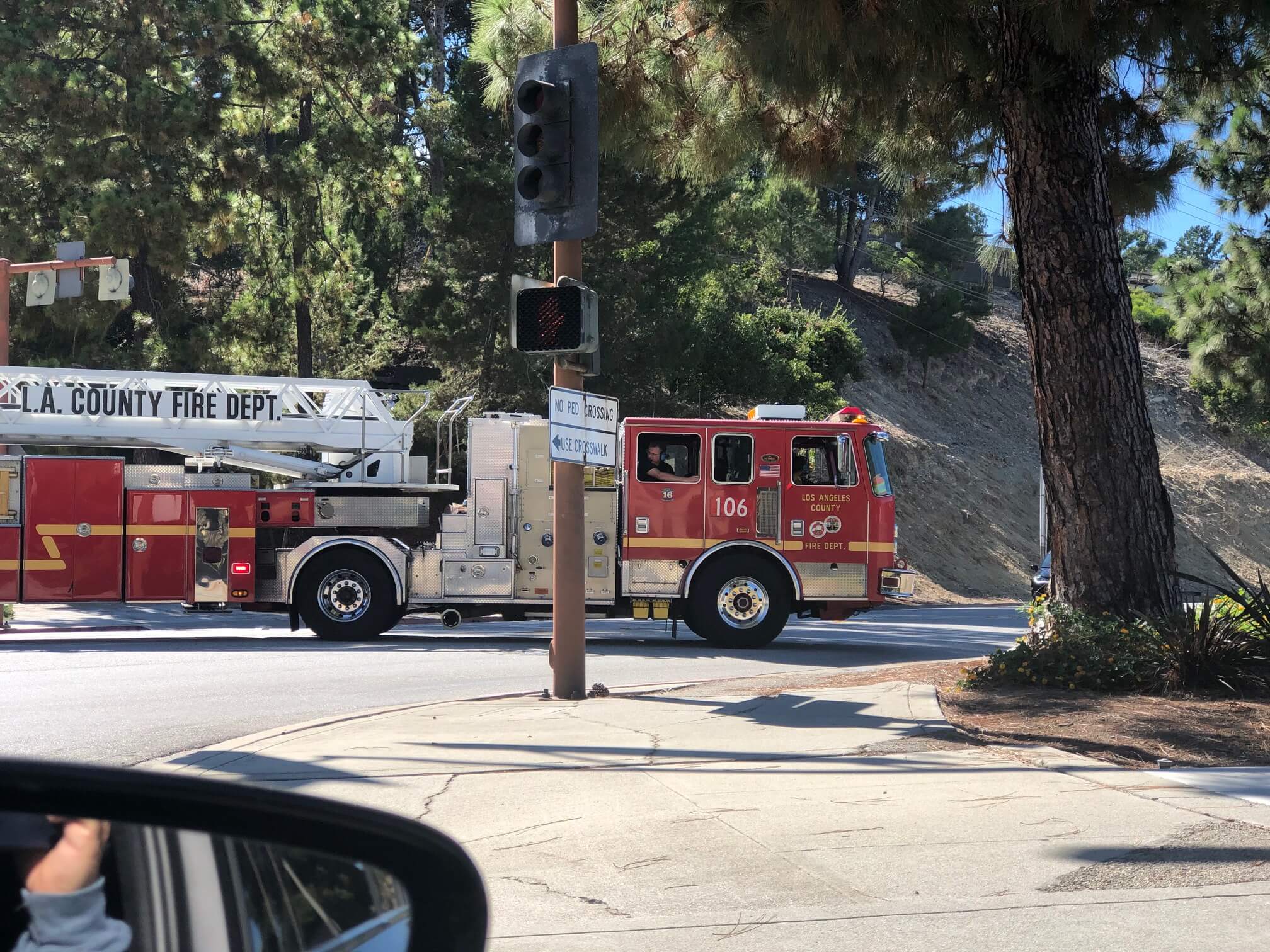
- Because of all the variables involved in cases like this, the legislature decided to make a hard and fast rule about “Turning and Stopping and Turning Signals” at our near fire stations as follows.
California Vehicle Code Section 22104 states:
“No person shall make a U-turn in front of the driveway entrance or approaches to a fire station. No person shall use the driveway entrance or approaches to a fire station for the purpose of turning a vehicle so as to proceed in the opposite direction.” [Emphasis] (Source).
Believe it or not, some daft vehicle operators will turn into the driveways and fire station parking lots, even with all these laws in place. People want to turn around to continue traveling in the opposite direction from where they were driving.No imagine a massive fire truck slamming into a small car, making an illegal U-Turn. It happens all the time in Los Angeles County.
RECAP: Drivers may not use the driveways leading to parking lots or approaches at or adjacent to fire stations to turn their vehicles around to travel in the opposite direction from whence they came.
Are U-Turns On California Highways Legal?
Believe it or not, you can legally make a U-Turn on a California Highway. Let’s take a look at what a “highway” is first.
- California Vehicle Code Section 360 defines a highway as follows:
“Highway” is a way or place of whatever nature, publicly maintained and open to the use of the public for purposes of vehicular travel. Highway includes street.” (Source).
So based on this definition, it appears that U-Turns are even legal on the freeways. But in an abundance of caution, we are doing more research. So don’t go out and start making U-Turns on the I-405 anytime soon, ok?
When Is It Legal To Make A U-Turn On The highway?
California Vehicle Code Section 22105 states:
“No person shall make a U-turn upon any highway where the driver of such vehicle does not have an unobstructed view for 200 feet in both directions along the highway and of any traffic thereon.” (Source).
Our interpretation of the statute is that If you drive on a highway and want to make a U-turn, an unobstructed view must present itself before you can do so. Moreover, highway drivers making U-Turns must be able to see a clear space of at least 200 feet in both directions before turning around on a highway—failure to obey subjects you to an infraction conviction and fine of $234. Moreover, a sentence can also increase your insurance rates since it adds a point to your DMV driving record.
RECAP: U-Turns are legal on highways if you have a 200-foot clear view. If not, you can cause a crash and be subjected to quasi-criminal penalties.
What Are The U-Turn Accident Statistics?
First of all, there were no official Los Angeles U-Turn Accident statistics we could find. All that is available are the statistics for the types of accidents commonly caused by U-Turns. Below is a list of Los Angeles accident percentages primarily associated with an illegal U-Turn.
Nationally, the July 2008 National Motor Vehicle Crash Causation Survey, Report to Congress is instructive.
“In about 36 percent of the crashes, the vehicles with critical reason were turning or crossing intersection.”
For example, on the whole, compared to all motor vehicle accidents, U-Turns received a 14 weighted score and 4,300 unweighted accident score, making up just 0.2% of the weighted percentages. (Source).
What Can I Do If I Was Hurt By A Driver Making An Illegal U-Turn?
Most people assume they can just sue. But it’s not that simple. For example, what if someone carrying expired auto insurance made an illegal U-turn and crashed into them? Sure, you have the right to file a personal injury claim against the lawbreaker. But what if you can’t recover any money? What good is the satisfaction of a judgment in your favor if no way to collect the money exists?
- What are the theories of negligence?
Before we digress too much, there are probably two theories you will for sure pursue. One is ordinary negligence, and the other is negligence per se. Let’s discuss negligence law first. Under California law, failure is shown by proving there was a duty by the defendant not to make a U-Turn until it was safe. So let’s say the court decides that the defendant was otherwise not violating the code section when the accident happened. For example, what if you were driving through a yellow, and the defendant was still in the process of negotiating a U-Turn? For example, the defendant was stalled in traffic and had the right to turn on a green arrow.
So here, it was still unsafe to turn around. And had the defendants paid more attention, the U-Turn would have been delayed, and the following distances would have been increased. So if you can prove the defendant breached the social duty by making the U-Turn when a reasonable person would not have done so, you can establish a breach of duty. But you’re still not done yet.
You must show that the breach resulted in injuries that were not your fault or only partially your fault. If the defendant’s action or inaction mostly caused your injuries, you must show damages, which can be mental, emotional, and physical. There is no requirement to show a financial loss because you can still recover money for pain and suffering even if you can’t make it to the hospital due to COVID waiting times.
However, claims involving statutory violations are different. If an accident is caused by a driver making an illegal U-turn, the statutory violation is considered negligent per se.
This means that the conduct will automatically be considered negligent, and the plaintiffs will not be required to prove that the defendants were negligent. In a lawsuit against a defendant whose conduct was negligent per se, the focus will prove that the illegal U-turn was the proximate cause of the injuries and financial harm the plaintiff suffered.
Under statutory negligence, or “negligence per se,” if the defendant had no right to make the turn, or was denied such privilege of the law, then you may have a case for negligence per se. And this is just a fancy way of saying a law was written to prevent a particular type of harm to a particular potential victim (here, an oncoming vehicle’s occupant). The defendant is presumed negligent if the code violation caused that particular harm.
So, because stopping the class of victim and type of harm suffered was the law’s goal, the law creates this rebuttable presumption of negligence. Again, the plaintiff still carries the burden of proving other elements of their case. So it does not result in an automatic judgment for the plaintiff. Also, the defendant can still shift the burden. (Learn more about negligence per se here).
Ok, so now, back to your other problem. What if the defendant driver is an illegal alien with no auto insurance? How do you get paid, then? Well, for one, you would not waste time suing under any theory when the person could go back home after abusing our immigration system. But a superior illegal U-Turn accident attorney will know exactly how to investigate and research the defendant and any coverages that could exist.
For example, what if the defendant delivered a package while working under the table for their boss when making the U-Turn? Maybe the defendant was lost and turning around to find the parcel drop-off point. In that case, you could go after the employer under a theory of vicarious liability.
As noted, even if the plaintiff violated the statute and himself was negligent per se, if the defendant could have avoided the crash exercising due diligence, the plaintiff can still recover damages under California’s pure comparative negligence laws.
In addition to illegal U-Turn laws, an officer may deem your illegal turn to be reckless driving to evade a ticket or get someone faster, for example.
So there are related laws to California Vehicle Code Section 21651(a), including:
- Reckless driving – Under California Vehicle Code Section 23103, driving with wanton disregard for people’s safety or property remains a crime. If only the lawbreaker is injured in a related crash, the defendant can be charged with a misdemeanor under Vehicle Code 23101. Punishment for a misdemeanor can include five to 90 days in county jail. Plus, a defendant can be subjected to a court-ordered fine of $145 to 1,000.12 dollars. However, if another person is killed or injured, more jail time and fines come into play. Either way, any reckless driving conviction will add two points to the defendant driver’s California DMV record.
- Evading a peace officer by traveling in the opposite direction of vehicular traffic. This is also a crime that speaks for itself.
RECAP: Never make a U-turn:
- At or on a railroad crossing.
- On a divided highway, crossing a dividing section, curb a strip of land, or two double yellow lines.
- Where you cannot see 200 feet in each direction because of a curve, hill, rain, fog, or other reason.
- Where a “No U-turn” sign is posted.
- When other vehicles may hit you.
- On a one-way street.
- In front of a fire station. Never use a fire station driveway to turn your vehicle around.
- In business districts. Areas with churches, apartments, multifamily housing units, and public buildings (except schools) are also considered business districts. Unless a sign prohibits it, it turns only at an intersection or where openings are provided for turns.
What Are Some Common Injuries We Help With Caused By U-Turn Accidents?
So due to the nature of illegal U-Turns, biomechanically, vehicle occupants are subjected to extreme inertia and G-forces, typically from a broadside collision. However, sideswipes and even head-on collisions at intersections are fairly common mechanisms of injury. Below we have compiled a list of injuries most commonly dealt with by our law firm from these types of crashes.
- Whiplash.
- Spine injuries.
- Disc burst fractures.
- Bulging disc, etc.
- Head injuries.
- Lacerations.
- Burn injuries.
- Wrongful death.
Although many car accident injuries seem to be the most prevalent in broadsides, which is the most common type of illegal U-turn collision.
How Much Money Can I Get For An Illegal U-Turn Accident?
Lawyers are not allowed to tell you that because it is unethical. We can give you a range of compensable damages and estimates by using paid experts at a potential case value. But ultimately, the court or jury makes the final decision on the amounts paid.
Typically, you can recover two types of damages in an illegal U-Turn accident case.
- Special Damages – Thee include medical bills from your past and into the future. So your lawyer must get experts to come up with estimates for future care, for example. Also included are last wages and even lost profits, assuming you lost your business, for example. Anything that costs you money, like a rental car, and vehicle repairs, are part of your economic or “special damages” in a personal injury case.
- General Damages – These are the damages insurance companies fear almost as much as punitive damages. These are for intangible past, present, and future losses. Often a jury will pay more in general damages when the plaintiff’s special damages are higher. The idea is that the plaintiff had to suffer by always going to physical therapy, losing their job, being unable to work out at the gym due to a disability, etc. Because of this, your lawyer will need to gather documentary evidence in the form of financial losses to show a correlation. However, you will be expected to keep a journal, take pictures of your bruising and injuries, and even make day-in-life videos. All of this tends to show your suffering.
What Do I Do After An Illegal U-Turn Accident?
Besides calling a lawyer, we suggest contacting the police, getting a police report, exchanging info with the defendant, and taking pictures of the accident scene. We have a comprehensive list of the seven most important post-accident steps to take here if you want to learn more.
Why Choose Ehline Law Firm Personal Injury Attorneys For Your U-Turn Accident Tort Claim?
Many of our clients ask themselves this before we meet. But never after. We use our decades of experience to give you the best possible odds for your future. We work on contingency. This means that we don’t ask for a penny unless we recover for you. Besides, in some cases, we can cover the cost of medical treatment upfront. We also work with only the finest medical professionals to properly assess your recovery.
We count in everything– the cost of medical treatment and physical therapy. The cost of lost work. The actual cost of emotional stress and trauma. We leave no stone left unturned. When our clients consider what a law firm can do for them– they understand that Ehline Law is an award-winning law firm due to its results, not any other factor. Contact a Los Angeles U-turn accident today to let us be there for you.
Ehline Law Firm has convenient personal injury law offices near you in Torrance, Los Angeles, San Bernardino, Riverside, and Orange County. And we are even in San Fransisco. Reach out for help!
Works Cited:
- “U-turn confusion for some drivers: Roadshow”: When are u-turns legal and illegal in California?
- California Department of Motor Vehicles: California Driver Handbook.
- CHP – NHTSA: https://www.nhtsa.gov/sites/nhtsa.dot.gov/files/documents/ca_chp555_manual_2_2003_ch1-13.pdf

